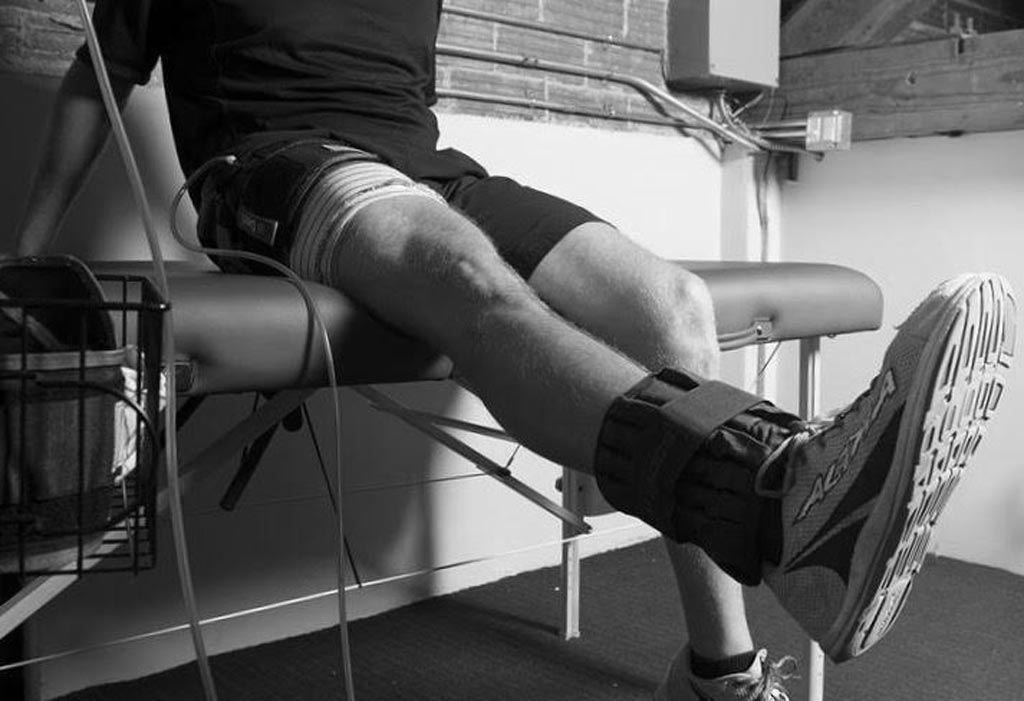Restricting Blood Flow May Prevent ACL Surgery Bone Loss
|
By HospiMedica International staff writers Posted on 27 Mar 2019 |

Image: A new study claims that restricting blood supply following ACL surgery preserves bone (Photo courtesy of ORS).
A new study suggests that combining blood flow restriction (BFR) therapy with traditional rehabilitation may slow bone loss following anterior cruciate ligament (ACL) reconstruction surgery.
Researchers at Houston Methodist Hospital (HMH; Houston, TX, USA) conducted a randomized prospective study that involved 23 physically active patients (mean age 23), who were divided into two groups following ACL reconstruction, BFR and control. While both groups received a similar rehabilitation protocol, during select exercises the BFR group worked out with an 80% arterial limb occlusion applied via an automated tourniquet. Bone mineral density, bone mass, and lean muscle mass were measured using dual-energy X-ray absorptiometry (DEXA).
The results revealed that the addition of BFR therapy to standard rehabilitation exercises prevented muscle mass loss in the whole leg and thigh, when compared to rehabilitation alone. The addition of BFR was also observed to minimize bone mineral content loss, preserving bone density in the treated limb compared to standard rehabilitation alone. The DEXA findings coincided with observed functional outcomes in the BFR group. The study was presented at the American Orthopaedic Society for Sports Medicine/Arthroscopic Association of North America (AOSSM/AANA) specialty day, held during March 2019 in Las Vegas (NV, USA).
“Providing BFR as part of the rehabilitation efforts following ACL surgery appears to help preserve the bone, recover muscle loss, and improve function quicker, “said lead author Bradley Lambert, PhD, of the HMH orthopedic biomechanics research laboratory. “While further research is needed to fully illuminate the physiologic mechanisms responsible, these findings likely have wide ranging implications for fields outside of ACL rehab alone, such as injury prevention, age-related muscle and bone loss, military rehabilitation, and potentially space flight.”
The ACL is a broad, thick collagen band that originates on the anterior portion of the femur in the intercondylar notch and inserts on the posterior aspect of the tibial plateau. The ACL guides the tibia through a normal, stable range of motion, along the end of the femur, maintaining joint stability. The ligament unfortunately is poorly vascularized, and thus has no real ability to heal after a complete tear, leading to further destruction of the articular and meniscal cartilage over time.
Related Links:
Houston Methodist Hospital
Researchers at Houston Methodist Hospital (HMH; Houston, TX, USA) conducted a randomized prospective study that involved 23 physically active patients (mean age 23), who were divided into two groups following ACL reconstruction, BFR and control. While both groups received a similar rehabilitation protocol, during select exercises the BFR group worked out with an 80% arterial limb occlusion applied via an automated tourniquet. Bone mineral density, bone mass, and lean muscle mass were measured using dual-energy X-ray absorptiometry (DEXA).
The results revealed that the addition of BFR therapy to standard rehabilitation exercises prevented muscle mass loss in the whole leg and thigh, when compared to rehabilitation alone. The addition of BFR was also observed to minimize bone mineral content loss, preserving bone density in the treated limb compared to standard rehabilitation alone. The DEXA findings coincided with observed functional outcomes in the BFR group. The study was presented at the American Orthopaedic Society for Sports Medicine/Arthroscopic Association of North America (AOSSM/AANA) specialty day, held during March 2019 in Las Vegas (NV, USA).
“Providing BFR as part of the rehabilitation efforts following ACL surgery appears to help preserve the bone, recover muscle loss, and improve function quicker, “said lead author Bradley Lambert, PhD, of the HMH orthopedic biomechanics research laboratory. “While further research is needed to fully illuminate the physiologic mechanisms responsible, these findings likely have wide ranging implications for fields outside of ACL rehab alone, such as injury prevention, age-related muscle and bone loss, military rehabilitation, and potentially space flight.”
The ACL is a broad, thick collagen band that originates on the anterior portion of the femur in the intercondylar notch and inserts on the posterior aspect of the tibial plateau. The ACL guides the tibia through a normal, stable range of motion, along the end of the femur, maintaining joint stability. The ligament unfortunately is poorly vascularized, and thus has no real ability to heal after a complete tear, leading to further destruction of the articular and meniscal cartilage over time.
Related Links:
Houston Methodist Hospital
Latest Surgical Techniques News
- Robotic Assistant Delivers Ultra-Precision Injections with Rapid Setup Times
- Minimally Invasive Endoscopic Surgery Improves Severe Stroke Outcomes
- Novel Glue Prevents Complications After Breast Cancer Surgery
- Breakthrough Brain Implant Enables Safer and More Precise Drug Delivery
- Bioadhesive Sponge Stops Uncontrolled Internal Bleeding During Surgery
- Revolutionary Nano Bone Material to Accelerate Surgery and Healing
- Superior Orthopedic Implants Combat Infections and Quicken Healing After Surgery
- Laser-Based Technique Eliminates Pancreatic Tumors While Protecting Healthy Tissue
- Surgical Treatment of Severe Carotid Artery Stenosis Benefits Blood-Brain Barrier
- Revolutionary Reusable Duodenoscope Introduces 68-Minute Sterilization
- World's First Transcatheter Smart Implant Monitors and Treats Congestion in Heart Failure
- Hybrid Endoscope Marks Breakthrough in Surgical Visualization
- Robot-Assisted Bronchoscope Diagnoses Tiniest and Hardest to Reach Lung Tumors
- Diamond-Titanium Device Paves Way for Smart Implants that Warn of Disease Progression
- 3D Printable Bio-Active Glass Could Serve as Bone Replacement Material
- Spider-Inspired Magnetic Soft Robots to Perform Minimally Invasive GI Tract Procedures
Channels
Critical Care
view channel
CPR Guidelines Updated for Pediatric and Neonatal Emergency Care and Resuscitation
Cardiac arrest in infants and children remains a leading cause of pediatric emergencies, with more than 7,000 out-of-hospital and 20,000 in-hospital cardiac arrests occurring annually in the United States.... Read more
Ingestible Capsule Monitors Intestinal Inflammation
Acute mesenteric ischemia—a life-threatening condition caused by blocked blood flow to the intestines—remains difficult to diagnose early because its symptoms often mimic common digestive problems.... Read more
Wireless Implantable Sensor Enables Continuous Endoleak Monitoring
Endovascular aneurysm repair (EVAR) is a life-saving, minimally invasive treatment for abdominal aortic aneurysms—balloon-like bulges in the aorta that can rupture with fatal consequences.... Read more
Wearable Patch for Early Skin Cancer Detection to Reduce Unnecessary Biopsies
Skin cancer remains one of the most dangerous and common cancers worldwide, with early detection crucial for improving survival rates. Traditional diagnostic methods—visual inspections, imaging, and biopsies—can... Read morePatient Care
view channel
Revolutionary Automatic IV-Line Flushing Device to Enhance Infusion Care
More than 80% of in-hospital patients receive intravenous (IV) therapy. Every dose of IV medicine delivered in a small volume (<250 mL) infusion bag should be followed by subsequent flushing to ensure... Read more
VR Training Tool Combats Contamination of Portable Medical Equipment
Healthcare-associated infections (HAIs) impact one in every 31 patients, cause nearly 100,000 deaths each year, and cost USD 28.4 billion in direct medical expenses. Notably, up to 75% of these infections... Read more
Portable Biosensor Platform to Reduce Hospital-Acquired Infections
Approximately 4 million patients in the European Union acquire healthcare-associated infections (HAIs) or nosocomial infections each year, with around 37,000 deaths directly resulting from these infections,... Read moreFirst-Of-Its-Kind Portable Germicidal Light Technology Disinfects High-Touch Clinical Surfaces in Seconds
Reducing healthcare-acquired infections (HAIs) remains a pressing issue within global healthcare systems. In the United States alone, 1.7 million patients contract HAIs annually, leading to approximately... Read moreHealth IT
view channel
Printable Molecule-Selective Nanoparticles Enable Mass Production of Wearable Biosensors
The future of medicine is likely to focus on the personalization of healthcare—understanding exactly what an individual requires and delivering the appropriate combination of nutrients, metabolites, and... Read moreBusiness
view channel
Philips and Masimo Partner to Advance Patient Monitoring Measurement Technologies
Royal Philips (Amsterdam, Netherlands) and Masimo (Irvine, California, USA) have renewed their multi-year strategic collaboration, combining Philips’ expertise in patient monitoring with Masimo’s noninvasive... Read more
B. Braun Acquires Digital Microsurgery Company True Digital Surgery
The high-end microsurgery market in neurosurgery, spine, and ENT is undergoing a significant transformation. Traditional analog microscopes are giving way to digital exoscopes, which provide improved visualization,... Read more
CMEF 2025 to Promote Holistic and High-Quality Development of Medical and Health Industry
The 92nd China International Medical Equipment Fair (CMEF 2025) Autumn Exhibition is scheduled to be held from September 26 to 29 at the China Import and Export Fair Complex (Canton Fair Complex) in Guangzhou.... Read more












